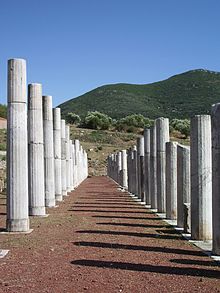Messene
Messene ( Greek Μεσσήνη ( f. Sg. )) Is an ancient Greek polis (city) in the southwest of the Peloponnese . It was the capital of Messenia in ancient times. A modern town of the same name Messini is located about 16 km southeast near the coast of the Messenian Gulf to the Ionian Sea and has about 23,000 inhabitants.
Geographical location
Strategically located between Mount Ithome (798 m), which is part of the city fortification, and Mount Eua, the city was able to develop well, as there were no neighboring larger cities.
history
The Theban general Epaminondas called after defeating Sparta who fled before the Spartan domination and widely scattered Messenians and founded 369 v. Chr. With them Messene as the capital of the new state Messinia . Messene still had some importance in the Roman Empire . The remains of a basilica document a settlement even in early Byzantine times.
archeology
A description of the ancient travel writer Pausanias (4.31 - 33) enables the identification of the monuments, which have been excavated to a considerable extent only recently and which are currently still being reconstructed and put up again. Messene has only been intensively researched in recent years and is the most extensive archaeological area in Greece. It is therefore subject to constant changes in terms of the state of excavation and reconstruction.
The stadium, 360 °
In the area of the ancient city center there are remains of the theater , the 40 m wide fountain house of the Arsinoe - the local legend after the daughter of the Messenian king Leukippus and mother of the god Asklepios ; adjoining this, a small approach to a hall has been exposed, probably the northern hall of the agora .
city wall
The formerly 9 km long city walls date from the time the city was founded - maybe not until the 3rd century - and are among the best preserved in Greece. The wall is secured by numerous towers with a semicircular and square plan. In the northwest is the monumental Arcadian Gate with a round inner courtyard. Outside the gate, the remains of some large tombs have been excavated.
Asclepion
The most important of these is the Asklepieion complex , which was dated soon after 215 BC. Is proposed. A ring hall temple ( Peripteros ) in Doric order with 6 to 12 columns and an altar building in front of it are located in a courtyard of about 66 m by 72 m approximating the square. The courtyard is surrounded on all sides by two-aisled halls ( stoa ), each with 21 or 23 columns on the fronts and a column position twice as wide inside. The columns are crowned by imaginative Corinthian capitals with depictions of erotics and bear a framework of fascia architrave and frieze , which is decorated with bull skulls and garlands ( bucranion ). Numerous rooms are attached to the outside of the halls: In the east, on the side of the main entrance ( propylon ), there is a meeting building ( Ekklesiasterion ) and two other large halls. In the west there is a series of smaller rooms, most of which open to the full width of the hall ( exedra ). Numerous statues were erected in them; one room served as a sanctuary for Artemis . Another monumental propylon is integrated in the northern row of chambers, which connects to the higher street and probably the agora with a staircase . In the areas to the side of these stairs, two large halls ( Sebasteion or Caesareion ) were subsequently set up to worship the Roman emperors.
Stadion
About 200 m further down the slope, a monumental stadium has been excavated in recent years - the most impressive and best-preserved ruin in the city. You enter the stadium at its northwest corner through a propylon that has been erected in a Doric order. Several graves of honor were uncovered there to the west immediately outside the stadium.
The northern part of the stadium is surrounded on all three sides by halls in a Doric order over a length of 110 m, from which numerous columns have been put up again. The north end of the running track is bordered by stone steps in a horseshoe shape, the grandstands at the south end were without seats and are now (2008) paved with grass. At the opposite end of the stadium, the starting area, was a heroon in the shape of a four- pillar prostylum temple , which is currently being rebuilt. According to the latest research, it is classified as the mausoleum of the Saithidae family, an influential family from the 1st to 3rd centuries AD.
literature
- Eva Maria Lang, Waltraud Sperlich: Messene: the dreamed metropolis . Kalamata, Lyso 2005. ISBN 960-630-274-1 Numerous pictures ( Memento from April 11, 2008 in the Internet Archive )
- Silke Müth: Our own way. Topography and city map of Messene in the late Classical-Hellenistic period (= International Archeology. Volume 99). Rahden / Westf. 2007. ISSN 0939-561X
- Claus Reinholdt: The Arsinoë fountain house in Messene. Useful architecture, representational architecture and hydrotechnology in the context of the Hellenistic-Roman water supply. Vienna 2009. ISBN 978-3-85161-024-6
- Petros G. Themelis: The ancient messene . Athens, TAP 2003. ISBN 960-214-206-5 .
- Petros G. Themelis: The Agora of Messene. In: Heide Frielinghaus , Jutta Stroszeck (ed.): New research on Greek cities and sanctuaries. Festschrift for Burkhardt Wesenberg on his 65th birthday (= contributions to the archeology of Greece. Volume 1). Bibliopolis, Möhnesee 2010, ISBN 978-3-933925-91-6 , pp. 105–125.
- William Frank Wyatt: Messene or Ithome (Mavromati) Messenia, Greece . In: Richard Stillwell et al. a. (Ed.): The Princeton Encyclopedia of Classical Sites. Princeton University Press, Princeton NJ 1976, ISBN 0-691-03542-3 .
Web links
Individual evidence
- ↑ According to the information board on site
Coordinates: 37 ° 10 ′ 31.8 ″ N , 21 ° 55 ′ 13.6 ″ E






